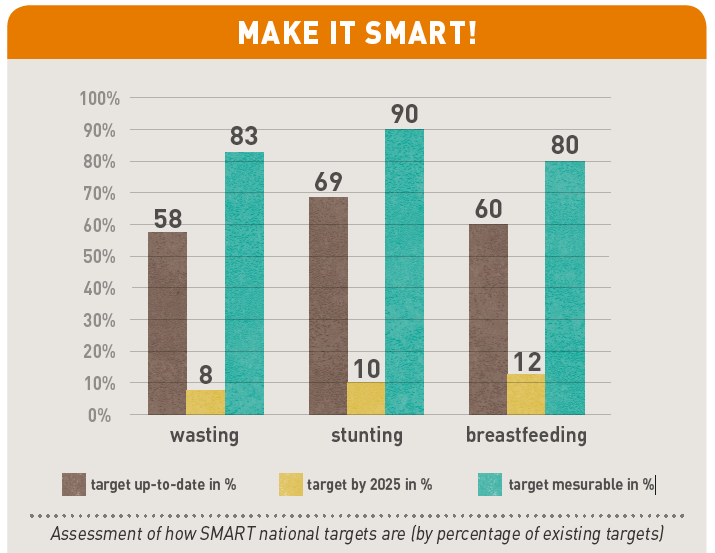By Ben Hobbs, Generation Nutrition Campaign Manager, and Christelle Hure, Action Against Hunger
On the occasion of the UN General Assembly and a side event on the Decade of Action on Nutrition, Generation Nutrition is launching a scorecard that looks at how well 50 ‘high-burden’ countries are doing in setting national nutrition targets and reaching global ones.
The scorecard – available to download below – reveals that half of governments in the countries with the highest levels of child malnutrition have yet to adopt national targets on wasting, stunting or exclusive breastfeeding.
The scorecard allocates points and ranks countries according to the following criteria:
1. Has a national target been set on wasting, stunting or breastfeeding? (Targets in national plans and Nutrition for Growth targets were considered.)
2. ‘SMARTness’ of target: is this target up-to-date? Is it measurable (baseline and objective clear)? Is it aligned with the period of the World Health Assembly global targets, i.e. does it run to 2025?
3. Is the country making progress towards the global targets on wasting, stunting and breastfeeding? (Our data source here was the Global Nutrition Report.)
Points were given for a country’s performance in each area (i.e. wasting, stunting and breastfeeding) and then an overall score was given, reflecting overall performance.
So, here were our main findings:
– Just four countries showed a high level of engagement on setting national targets and reaching global ones: Kenya, Laos, Mauritania and Sierra Leone. 11 others – mostly African states – demonstrated a medium level of engagement. The other 25 scored ‘low’ or ‘very low’.
– As already mentioned, around half of countries had adopted a national target on wasting, stunting or exclusive breastfeeding. Only 18 countries had adopted all three targets.
– A high proportion of the targets were measurable (66 out of 78); however very few were aligned with the 2025 timeframe (8 out of 78) and as many as one-third were either out of date or soon to be as they only ran until the end of 2016.
– 30 of the countries on the high-burden list are from Africa. However, our analysis showed that these countries were outperforming their 19 Asian counterparts and by a considerable margin. Only 16% of the Asian countries on the scorecard demonstrated a ‘high’ or ‘medium’ level of engagement when it came to setting national nutrition targets and making progress towards the global targets. By contrast, 40% of African countries were in these top two categories.
In 2012, the World Health Assembly (WHA) adopted a landmark resolution establishing six global nutrition targets. Since then, progress towards these targets has been slow (as we reported recently in our ‘Nutrition Funding: The Missing Piece of the Puzzle‘ report). Setting national targets can help to build momentum towards reaching the global targets and also provides a clear goal for national plans and programmes. At this year’s WHA, all states approved a resolution that recommended the adoption of more national nutrition targets.
Our scorecard results show clearly the need for more governments in high-burden countries to adopt SMART, context-specific nutrition targets. These should be aligned with the WHA global targets’ timeframe, or, at the very least, be renewed if they are outdated.
Setting national nutrition targets is an essential step towards the reduction of malnutrition. Targets and progress often go hand-in-hand. Generation Nutrition urgently calls on all governments to show a high level of ambition in order to save lives and ensure good nutrition.
Originally posted on the Generation Nutrition website.

